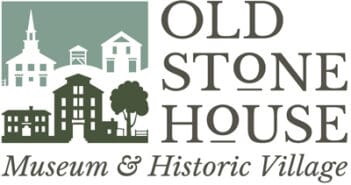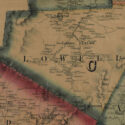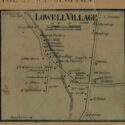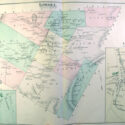From the Vermont Historical Gazetteer, edited by Abby Maria Hemenway. Orleans County – Lowell Chapter: By Various Authors. Published by Claremont Manufacturing Co, 1877. Pgs 269-281
LOWELL.
This township is bounded N. by Westfield, Troy and Coventry Gore, E. by Irasburgh and Albany, S. by Eden and Belvidere, and W. by Montgomery. It was granted for 39,000 acres, but, upon surveying, was found to contain 42,000. The south line-the only straight line-being 12 miles, and the east 10 miles. By act of legislature, Nov. 18, 1852, one tier of lots, in the range adjoining Irasburgh was annexed to that town; and, by act of legislature, Nov. 5, 1858, 13 lots in the 18th range, and all the ranges west of this range, were annexed to Montgomery. The present area of the town is 33,115 acres. Lowell lies 36 miles N. from Montpelier, and 42 miles N. E. from Burlington. It was first chartered by the name of Kelly Vale; but, owing to the unpopularity of this cognomen among the settlers, or for some other reason, that no one now knows, its name was changed to the one it now bears.
It appears that Kelley, to whom it was first granted, sold his grant to Messrs. Franklin and Robinson, in New York, who failed, and the grant passed to the hands of M. Mawhurst in the City of New York, a few lots of which remain in the hands of his heirs to the present day. From some old conveyances, we infer that Kelley’s interest passed, as soon as obtained, into his creditors hands, among whom were Alexander Hamilton and Livingston of New York, and other speculators there in wild lands in Vermont. The town was once sold to one William Dewes for $4,680; and the titles have been transferred from one speculator to another, till no regular gain of titles can now be traced, down to this date. To the west may be seen Hazen’s Notch, through which Col. Hazen attempted to open a road during the Revolution. He encamped for several days with a part of his regiment on the flat where W. H. Blasdell’s store now stands. For some 15 years this was the only road through the unbroken wilderness, in this part of Vermont. This road had been cut some 8 years before the first tree was felled for a permanent settlement in Kellyvale. To the north-west, Jay Peak rises in view, pointing its lofty head toward heaven, as if reminding man of his origin and proper destiny.
The town is watered by the Missisco [sic] and its tributaries. This river is the outlet of a pond situated in the south-western part of the town. A tributary rising in the southeastern part of the town, uniting with this, below the village, affords valuable mill-sites, which have been mostly improved. The forest-trees are mostly spruce, hemlock and maple, although beech, birch, &c., are quite abundant. The soil, generally, is productive, yielding a good harvest to the husbandman. The town is one of interest to the mineralogist. It possesses a great variety of minerals. Asbestos, serpentine, in most beautiful specimens, abound in considerable quantities.
ORGANIZATION, &C.
The town originally belonged to Chittenden County. It was granted March 5, 1787, and chartered by Gov. Thos. Chittenden, to John Kelley, Esq., of New York, from whom it received its original name-Kelleyvale. Nov. 1, 1831, the name was altered to Lowell.
The first settler was Major Wm. Caldwell, from Barre, Mass, who began to make improvements on his land in the year 1803, but did not move his family into town until April, 1806. In the Spring of 1807, came John Harding, assisted by four others, drawing his family and goods into town on hand-sleds; others soon followed. March 12, a petition signed by nine of the inhabitants, was made, to one Medad Hitchcock, one of the justices of the County, requesting him to warn a meeting of the inhabitants for the purpose of organizing the town.
FIRST THINGS.
The first Post Office was established in 1819, with Abel Curtis as postmaster, who held the office 20 years. The first birth and death was a son belonging to John Harding. The first marriage on record is that of Jonathan Powers to Miss Relief Stewart, Dec. 3, 1812.
Abel Curtis built the first framed house in town, which he also tore down in 1842, to build new upon the same site. He also married the first couple in town, viz. Mr. Jonathan Powers to Miss Lila Stewart. The first death and burial in town was that of a Mr. Dunham, who was killed by the falling of his hay-barrack upon him, and who was interred in the present burying ground. The first settled minister in town was Rev. Jubilee Wellman, who drew the ministerial lot of land, and was settled in 1849. He tarried with his people a few years when death took him from his flock, and the town was without a minister about 12 years. The first school numbered 12 scholars, taught by Abel Curtis. There are 6 districts now in town, with newly built school-houses in each. In district No. 1, they have a house which was built for a graded school, and cost $ 2,000. In 1866, they organized the Lowell Library Association, which has 125 volumes, already of well selected books, and money in the treasury. There is also a flourishing Sunday-school with a large library of selected books.
CONGREGATIONAL CHURCH.
Its history dates back to Jan. 10, 1816. It was organized by the Rev. Nathaniel Rawson of Hardwick, and Rev. James Parker, of Enosburgh [sic], with a membership of 6 persons three of each sex. They had no regular places for worship, and were obliged to hold their meetings in dwelling and school houses. Notwithstanding the fewness of their numbers, and their poverty, they felt it to be a duty and privilege devolving on them, to erect a suitable structure for worship. A meeting was called which resulted in the formation of an association for that purpose. The plan of the house was determined, and the site selected, the erection commenced in the year 1841, but was not completed until the following year. It was under the control of the Congregationalists and Methodists, each having reciprocal rights, and each were to supply the pulpit alternately.
It was stipulated in the constitution, which was adopted by both societies, that, whenever either denomination wished to occupy the house exclusively, they could do so by purchasing of the other society their right in the house, which was effected, by mutual agreement.
Aug. 1, 1849, an invitation was extended to the Rev. Jubilee Wellman, to become their pastor. The invitation received a favorable reply, and he entered upon his labors, Sept. 1, 1849; and in a few months was installed pastor. The prospects of the church now seemed to improve. But the death of the beloved pastor, early in 1855, spread a deep gloom over the people. He was held in much esteem by his flock, and his death was the occasion of much sorrow.
CATHOLIC CHURCH.
A very neat church edifice has been erected this year, (1869) by the Catholics of this town. One of the Priests of Hamstead, says Mass here once a month on a Sunday. There may be some seventy Catholic families, attending the church at Lowell.
SABBATH-SCHOOL.
The Sabbath-school work in Lowell, although far from being perfect, has not been lost sight of. The first attempt to organize a Sabbath-school in this town, was made by Miss Laura Washburn, a district school teacher from Greensboro in the Summer of 1820. (Her father started the first Sabbath-school movement in that town, and one of the first in the State.) There were present at that school the first Sabbath 13 souls, from 4 to 16 years old. Some parents in the district kept their children aloof from the school, for fear it would draw off their attention from their week-day studies. One member of that little band still survives who has made her home in this town ever since; and who has seen that little shoot, planted in the wilderness, by that brave and devoted girl, grow on, year by year, often buried beneath the snows of Winter but, with the return of Spring, putting forth its leaves and taking deeper root in the hearts of the people, until the Sabbath-schools in Lowell are among the fixed institutions of the place. No records of the schools are known to be in existence, but those of the last few years. There are connected with the Congregational Sabbath-school, at this time (November, 1869).
The Baptist brethren labored, in different parts of the town, for several years, until about 2 years since, when they built a place of worship at the lower village, where they have been making steady progress, and now have a flourishing school. Missionary work has been carried on, in several districts, with different degrees of success. In the south part of the town, the greatest interest has been shown in the work. Nearly a whole neighborhood has been brought under the influences of the gospel by the Mission Sabbath-school. In one mountain district, last spring, an appointment was given out, for a meeting to organize a school the next Sabbath morning at 9 o’clock, at the school-house. Some of the children were on the spot at 71/2 o’clock, and stood their ground until the expected help arrived from the village. In another district, one of the most remote in town, a mother plead for a Sabbath-school to be carried on, that her children and others might receive the benefit of its teachings. But all in vain. The harvest was truly great, but the reapers few. The energies of every worker were already taxed to the uttermost. Thus the work goes on. Some of our leaders have fallen while nobly bearing the banner of the cross.
HARD TIMES.
The hardships which the first settlers endured their indomitable perseverance, seem worthy for notice. Shut off, as it were, from the outside world, the roads being few and almost impassable, it was with great difficulty that they gained communication with the neighboring towns. The nearest store was located at Craftsbury, a distance of 12 miles. Having no mills they were obliged to carry their grain to an adjoining town, sometimes through mud, again through the deep, trackless snow. Throwing their bags of grain across their backs, or their horse’s, they would commence their journey, it taking them nearly a day to go and return. The disadvantages and inconveniences of living at a considerable distance from one another, was another serious evil which they encountered. It is related that Maj. Walker having cut his foot, and being destitute of fuel, his wife donned his apparel and waded through the snow, a distance of 3 miles to
Maj. Caldwell’s to procure assistance, He immediately returned with her, taking his son with him, whom he left to cut fuel &c., until Maj. Walker should recover.
The cold season of 1816, was one of great suffering among the settlers. Great scarcity of provision prevailed, one family by the name of Butterfield, being reduced to such a state that they were, obliged to subsist on clover heads for several days, Mrs. Butterfield performing the hard labor of spinning and weaving during the time.
THE WAR or 1812.
The inhabitants shared with those of other towns in the panic caused by the war of
1812. A fort was erected near where the Congregational church now stands, for a sort of refuge in times of danger, Dea. Ebenezer Woods, and Abel Curtis were appointed delegates to a meeting holden at Potton, P. Q. to ascertain, if might be, the state of feeling which existed among the people in Canada. They found the inhabitants as much disposed to have peace as themselves. This news in a great measure quieted the fears of the panic-striken, and less fears were entertained of an invasion. They had no occasion to remove into the fort, and it was afterwards used as a pound.
TEMPERANCE.
The town has suffered much from the effects of intemperance. For a long time, traffic in intoxicating liquors was carried on to a considerable extent. Though not wholly free from its blighting influences, yet a mighty revolution has taken place within the last few years. Some of the young men saw and felt the need of a reformation. Nearly 4 years ago a Good Templars Lodge was organized. As a reward of their labors, they have had the satisfaction of seeing many rescued from the jaws of the fiery-demon. The Lodge has sustained weekly meetings since its formation. It now has about 100 active members.
EDUCATIONAL.
Provisions for schools were made as soon as the town was organized. The following appears on record. “Voted to raise one cent on the dollar on the Grand List, paid in grain, for the support of schools.” The town originally contained but one district. It now contains seven and three fractional ones.
The first school was taught by Abel Curtis in a dwelling-house situated a few rods back of his present residence. The first schoolhouse was erected near where Carlos Farman now resides. It was a log structure, although as comfortable as their own dwellings. Other districts were formed, and schools established, according as the settlement of the town demanded. Under the supervision of superintendents the schools have greatly improved, and the people are giving more attention to the subject of education. Each district now has a neat commodious house, showing that the people appreciate the blessings of intelligence and cultivation in those around them.
MILLS
Col. E. Crafts built a saw-mill for the proprietors in 1805, where the saw-mill of Parker Bros, now stands. Abel Curtis built a grist-mill in 1812, by the natural bridge spoken of in Thompson’s Gazetteer, which well served the inhabitants of this town 18 years. Cobb & Kelton put up a grist-mill at the falls in 1831, which, 6 years later, was burned: cause unknown. Wm. S. Flint built a grist-mill on the same site in 1838, which stood about 18 years and was burned. The old site is now occupied by the clap-board shop of Paine 4 Root. M. Work built a grist-mill in 1860, a little below the site of the Abel Curtis mill. There was a saw-mill built on the west hill below Walker pond, which has been rebuilt several times, has been in the hands of many owners and is nearly run down.
In January, 1843, a sash-shop was put in operation on the opposite site of the stream, which at the present time is doing quite a large amount of work in window-blinds, doors and sash. Shipley A Warner built a starch-factory, which they run one year, when they failed, and it went into the hands of Wm. S. Flint who sold in 1839 to Woolley & Co., who ran it till Dec. 2, 1812, when it was burned, but rebuilt and running in two months from the day it was burned.
PONDS AND FISH.
This township has two ponds, Eden pond, which also belongs in part to Eden and which is the head of the Missisquoi; and Walker pond in the western part of the township, which has an area of two acres of water, and was formerly stocked with fine trout. It received its name from H. Walker who located near this pond in the early settlement of the town. In the Summer of 1847, Blake Aldrich and Benj. F. Pickett went to the pond, the afternoon of one lowry day, and returned at night with 96 pounds of trout.
SOIL AND MINERALS.
In the northern part of the township is a clay soil; in the center it is sandy, and in the rest of the township a sandy loam. Among the hills and valleys are found serpentine, feldspar, amianthus, pudding-stone, and asbestus [sic]. The latter has furnished specimens for all the New England and some of the Middle and Western States colleges. Iron has also been dug from the swamp and worked at Troy. Near the north line of the town is a spring impregnated with iron and sulphur, which no doubt will be resorted to at a future day, as its healing qualities are great; but being so remote, it is not so well known.
ROADS
First was the Warren road which passed in a north-western course through the town, and next, or in 1828, there was a County road laid from Burlington to Derby Line, which passed through Lowell north, and south from Eden to Westfield, and was the only mail route. There was also at this time or soon after, a road over the mountains to Irasburgh but this road was very rough and steep, and not traveled in the winter.
Apr. 5, 1842, Mr. Jona. Stewart wished to go over to Irasburgh to pay a debt at the bank, and thought he could go over the mountain which would be but 9 miles, while by way of Troy it was 20 miles, with road bare and bad. He crossed over the mountain upon the snow-crust in the morning very well, paid his debt at the bank and started to return. He left the last house in Irasburgh, the sun two hours high, and began to ascend the mountain. The snow had softened during the day, through which with the anxiety of getting home, he wallowed three miles, when, wearied out, he lay down and rolled quite a distance down a hill, at the foot of which he stretched himself oat upon the snow with his cap under his head and his hands crossed upon his breast and went to sleep- within two rods of a family in their snug, warm log-house.
The next day, Luther H. Brown of Eden came out to Lowell on the way to Irasburgh on the same errand and finding the road had thought too, that he would attempt the mountain road. Brown, who was some 20 years younger than Stewart, traveled briskly on till he entered the four-miles wood, when his progress was slow as there was no other road than that made by Stewart the day before, and the snow was soft. He however continued on till he arrived where the lifeless body of poor Stewart lay. Greatly alarmed at the sight of what might have been his own fate had he gone on and attempted to return as this man had, he hurriedly retraced his steps for help. The citizens turned out, a jury was summoned, who, having repaired to the spot, rendered a verdict “died from exhaustion and exposure,” and the body was made fast to a pole and borne by the men, taking turns, a mile and a half, to the first place where a team could meet them, when it was conveyed by the team to his home and his family, who little thought of such a return when he left them hale and hearty the day before.
VILLAGE.
Lowell village is not so compact as some villages-as nature has so made the place. There are 5 streets, none of them parallel with others. It has 2 stores, 1 hotel, a post office, 2 houses for public worship, 2 starch-factories, 2 clap-board-mills, 1 grist-mill, about 30 dwellings and a chance for improvement.



